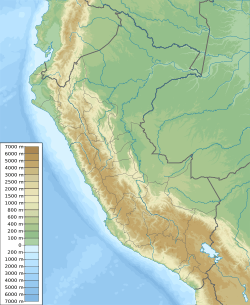Soro Mik'aya Patjxa facts for kids
| Region | Ilave Basin, Lake Titicaca Basin, Andean Altiplano |
|---|---|
| Coordinates | 16°14′2″S 69°43′30″W / 16.23389°S 69.72500°W |
| Altitude | 3,860 m (12,664 ft) |
| Type | open-air seasonal residential site |
| Area | 2,800 m2 (30,139 sq ft) |
| History | |
| Founded | 8,000 BP |
| Abandoned | 6,700 BP |
| Periods | Middle to Late Archaic periods |
| Associated with | hunter–gatherers |
Soro Mik'aya Patjxa is an ancient archaeological site high up in the mountains of Peru. It is located in the Ilave Basin, about 30 miles (48 km) west of Lake Titicaca. This site was a place where hunter-gatherers lived for parts of the year. They used it regularly for over a thousand years.
Contents
Discovering Soro Mik'aya Patjxa
The site sits on a flat area near a river. It was first found by archaeologist Mark Aldenderfer in 1995. When scientists dug into Soro Mik'aya Patjxa, they found one main layer of earth that showed signs of human activity. They dug 13 pits at the site to learn more. People lived here at least 1,500 years before farming started in this area around 5,000 years ago.
Ancient Objects Found
More than 80,000 ancient objects, called artefacts, were found at the site. Most of these objects were stone tools made by chipping pieces off rocks. Scientists also found bones, stones that had been ground smooth, burnt plant pieces, and colored stones like red ocher. Some pieces of pottery were also found. However, these pottery pieces looked like they were made much later, around 1,000 AD. This means they probably came from a different time and were not part of the original settlement.
Human Remains and Ancient People
Scientists found the remains of 16 people buried in pits at the site. Five of the skulls showed signs that their heads had been shaped on purpose. This was a common practice in some ancient cultures.
By studying the chemicals in the bones (called isotopic analysis), scientists learned more about these people. They also looked at how far these people might have traveled to lower areas. All the evidence suggests that the people at Soro Mik'aya Patjxa lived in this high-altitude environment all the time. They used local stone materials a lot, which also supports this idea.
What They Ate
The people at Soro Mik'aya Patjxa probably hunted large animals and ate a lot of plants. Many of the stone tools found were projectile points, like arrowheads or spear points. This shows that hunting was very important. Most of the animal bones found were from large mammals, likely deer and vicuña. They also ate smaller animals like guinea pigs, mountain viscachas (a type of rodent), and carache fish. Many of the animal bones found had been burned, meaning they cooked their food.
The large number of ground stones at the site suggests that processing and eating plants was also a big part of their diet. Scientists looked at the teeth of the ancient people. Only one out of 251 teeth had a cavity, which is common for hunter-gatherers. The wear on their teeth also showed they ate a diet typical of people who hunted and gathered on land. The tooth wear also suggested they ate a lot of tubers, which are root vegetables like potatoes.
Ancient DNA Discoveries
In 2018, scientists were able to study the DNA from a male skeleton found at the site, named SMP5. This man lived around 6,800 years ago. His DNA is similar to later ancient DNA samples from the Lake Titicaca area. It is also found in people living in the Andes mountains today.
When compared to modern people, SMP5s DNA is most similar to the Quechua people and the Aymara people. Interestingly, SMP5s DNA also shows a connection to modern people from Siberia, especially the Yakuts. This link is also seen in some other very old skeletons found in North and South America.


